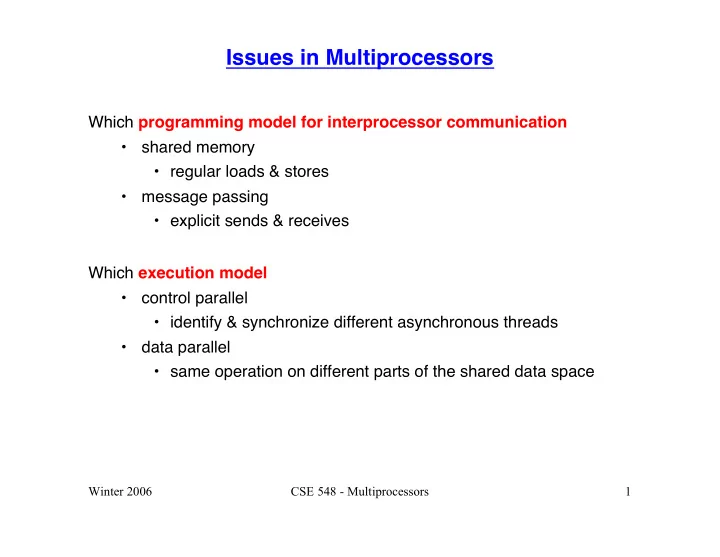

Issues in Multiprocessors Which programming model for interprocessor communication • shared memory • regular loads & stores • message passing • explicit sends & receives Which execution model • control parallel • identify & synchronize different asynchronous threads • data parallel • same operation on different parts of the shared data space Winter 2006 CSE 548 - Multiprocessors 1
Issues in Multiprocessors How to express parallelism • language support • HPF, ZPL • runtime library constructs • coarse-grain, explicitly parallel C programs • automatic (compiler) detection • implicitly parallel C & Fortran programs, e.g., SUIF & PTRANS compilers Algorithm development • embarrassingly parallel programs could be easily parallelized • development of different algorithms for same problem Winter 2006 CSE 548 - Multiprocessors 2
Issues in Multiprocessors How to get good parallel performance • recognize parallelism • transform programs to increase parallelism without decreasing processor locality • decrease sharing costs Winter 2006 CSE 548 - Multiprocessors 3
Flynn Classification SISD : single instruction stream, single data stream • single-context uniprocessors SIMD : single instruction stream, multiple data streams • exploits data parallelism • example: Thinking Machines CM MISD : multiple instruction streams, single data stream • systolic arrays • example: Intel iWarp, streaming processors MIMD : multiple instruction streams, multiple data streams • multiprocessors • multithreaded processors • parallel programming & multiprogramming • relies on control parallelism: execute & synchronize different asynchronous threads of control • example: most processor companies have MP configurations Winter 2006 CSE 548 - Multiprocessors 4
CM-1 Winter 2006 CSE 548 - Multiprocessors 5
Systolic Array Winter 2006 CSE 548 - Multiprocessors 6
MIMD Low-end • bus-based • simple, but a bottleneck • simple cache coherency protocol • physically centralized memory • uniform memory access (UMA machine) • Sequent Symmetry, SPARCCenter, Alpha-, PowerPC- or SPARC- based servers Winter 2006 CSE 548 - Multiprocessors 7
Low-end MP Winter 2006 CSE 548 - Multiprocessors 8
MIMD High-end • higher bandwidth, multiple-path interconnect • more scalable • more complex cache coherency protocol (if shared memory) • longer latencies • physically distributed memory • non-uniform memory access (NUMA machine) • could have processor clusters • SGI Challenge, Convex Examplar, Cray T3D, IBM SP-2, Intel Paragon Winter 2006 CSE 548 - Multiprocessors 9
High-end MP Winter 2006 CSE 548 - Multiprocessors 10
Comparison of Issue Capabilities Winter 2006 CSE 548 - Multiprocessors 11
MIMD Programming Models Address space organization for physically distributed memory • distributed shared memory • 1 global address space • multicomputers • private address space/processor Inter-processor communication • shared memory • accessed via load/store instructions • SPARCCenter, SGI Challenge, Cray T3D, Convex Exemplar, KSR-1&2 • message passing • explicit communication by sending/receiving messages • TMC CM-5, Intel Paragon, IBM SP-2 Winter 2006 CSE 548 - Multiprocessors 12
Shared Memory vs. Message Passing Shared memory + simple parallel programming model • global shared address space • not worry about data locality but get better performance when program for data placement lower latency when data is local • but can do data placement if it is crucial, but don ’ t have to • hardware maintains data coherence • synchronize to order processor ’ s accesses to shared data • like uniprocessor code so parallelizing by programmer or compiler is easier ⇒ can focus on program semantics, not interprocessor communication Winter 2006 CSE 548 - Multiprocessors 13
Shared Memory vs. Message Passing Shared memory + low latency (no message passing software) but overlap of communication & computation latency-hiding techniques can be applied to message passing machines + higher bandwidth for small transfers but usually the only choice Winter 2006 CSE 548 - Multiprocessors 14
Shared Memory vs. Message Passing Message passing + abstraction in the programming model encapsulates the communication costs but more complex programming model additional language constructs need to program for nearest neighbor communication + no coherency hardware + good throughput on large transfers but what about small transfers? + more scalable (memory latency doesn ’ t scale with the number of processors) but large-scale SM has distributed memory also • hah! so you ’ re going to adopt the message-passing model? Winter 2006 CSE 548 - Multiprocessors 15
Shared Memory vs. Message Passing Why there was a debate • little experimental data • not separate implementation from programming model • can emulate one paradigm with the other • MP on SM machine message buffers in local (to each processor) memory copy messages by ld/st between buffers • SM on MP machine ld/st becomes a message copy sloooooooooow Who won? Winter 2006 CSE 548 - Multiprocessors 16
Recommend
More recommend